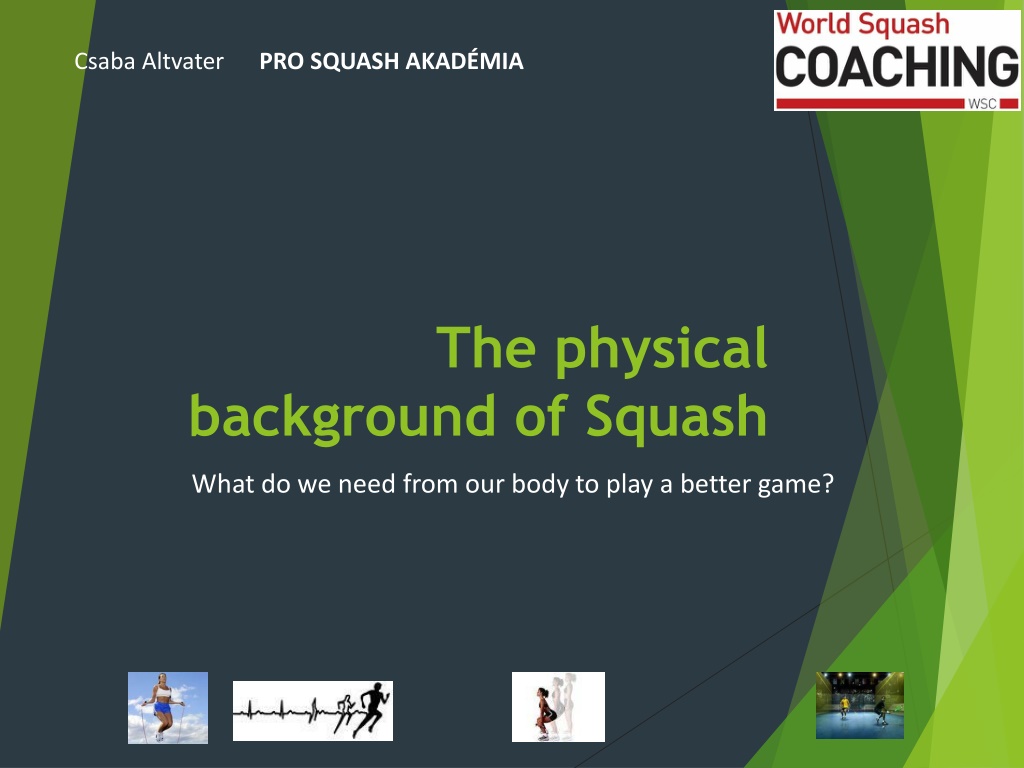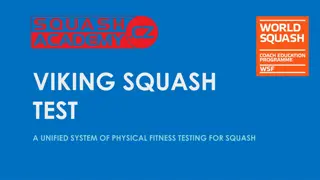Understanding the Physical Demands of Squash and Energy Systems
Squash requires a combination of physical skills such as cardiovascular endurance, stamina, strength, flexibility, power, speed, coordination, accuracy, agility, and balance. To play a better game, it is essential to understand the energy systems of the human body: phosphagen, aerobic, and anaerobic. Each energy system plays a crucial role in providing ATP, the energy source for muscle contractions during exercise. Proper nutrition, including a balanced intake of carbohydrates, fats, and proteins, is also important. Starting exercise with a warm-up and proper planning based on test results can help improve performance in squash.
Download Presentation

Please find below an Image/Link to download the presentation.
The content on the website is provided AS IS for your information and personal use only. It may not be sold, licensed, or shared on other websites without obtaining consent from the author. Download presentation by click this link. If you encounter any issues during the download, it is possible that the publisher has removed the file from their server.
E N D
Presentation Transcript
Csaba Altvater PRO SQUASH AKADMIA The physical background of Squash What do we need from our body to play a better game?
Energy systems of the human body One of the key drivers to exercise is the utilisation of energy from our body. The body has a number of systems that produces energy, each system works by converting energy to a common unit known as Adenosine Tri-phosphate (ATP). Without getting too technical and exploring the molecular structure of ATP, all we need to know is that ATP is the energy of our cells. As we exercise, the muscles in our body contract to perform specific movements. These muscle contractions or extensions are supported by ATP, therefore as we exercise our demand for energy increases and thus ATP requirements increases. There are fundamentally three energy systems in our body that produces ATP; - Phosphagen - Aerobic - Anaerobic (Glycogen Lactic-acid system) -Phosphate energy system, used for immediate hugh intensity work - 0-10sec -Anaerobic energy system, the process of releasing energy from food in the form of glucose without the presence of oxygen. - 1-2min -Aerobic energy system, releasing energy with presence of oxigen - 2- min
Anaerobic Energy System Due to the nature of anaerobic exercises, often more explosive and sudden, ATP is required at a faster rate. The anaerobic system produces ATP via two different pathways: - Phosphocreatine: stored within our muscles and is similar to ATP. (Quite often body builders will take some form of creatine supplement, this is where this is used) - Lactate Anaerobic System: Evident when our muscles fatigue and we hear people express, Lactic Acid buildup (which is the product of this pathway) Either pathway, the anaerobic energy system cannot continue indefinitely as ATP or phosphocreatine becomes depleted or an accumulation of lactic acid builds up causing pain and fatigue. Aerobic Energy System As the name suggests, the Aerobic Energy System focuses on the production of ATP through the breakdown of food stores with the use of Oxygen. As we exercise the demand of energy from our muscles increase, as does the demand for oxygen. Therefore the heart pumps faster and stronger to transport oxygen through the body. This energy system breaks down carbohydrates, fatty acids and some amino acids to produce ATP. Aerobic activities are commonly lower intensity and is usually sustained over a longer period of time therefore the Aerobic Energy System is predominate in these cases.
Basic Energy Intake -CARBOHYDRATES 50% of the food intake, -FAT 30% of the food intake -PROTEIN 20% of the food intake Also important components: minerals, vitamins, water Starting your exercise -Warm-up -Start with easy exercise -Use enough resting periods -Measure your client s results and recovery -Be flexible to replan the program based on the tests
Important Physical Skills -Cardiovascular Endurance Kering si rendszer ll k pess ge -Stamina -Strength -Flexibility -Power -Speed -Coordination -Accuracy -Agility -Balance Kitart s Er Rugalmass g/hajl konys g Teljes tm ny Sebess g Koordin ci Pontoss g gyess g Egyens ly Speed SQUASH Strength Endurance
Stamina Agility ENDURANCE SPEED Controlled mentally using Power Flexibility ACCURACY Balance Coordination STRENGTH
Tools for Physical Development - Lower the Center of Gravity Point - Involve the CORE - Mimic Game Situations - High Intensity Interval Training - Base on Assesment
SET THE MESO CYCLE - SET UP YOUR 6 WEEKS GOAL - VARY THE PRESSURE FOR DIFFERENT SKILLS BASED ON TESTS - FOCUS ON 1 OR 2 SKILLS MAINLY IN 1 MESO C. DURING MESO CYCLE: - DECREASE QUANTITY - LESS RESTING TIMES - LESS STRENGTH - INCREASE QUALITY - INCREASE INTENSITY - MORE SPEED, ACCURACY
Building up your plan Phases: -Preparation - pre season , when you build up skills -Competition in season, when you keep up skills , less chance for serious development -Active rest off season, recovery and recuperation The MACRO-cycle, with the MESO-cycles 100% 90% 80% 70% 60% 50% 40% 30% 20% 10% LOAD OF WORK TERHEL SI G RBE J N J L AUG SZEP OKT NOV DEC JAN FEBR M R PR M J 100% 90% 80% 70% 60% 50% 40% 30% 20% 10% PLANED PERFORMANCE TELJES TM NY G RBE J N J L AUG SZEP OKT NOV DEC JAN FEBR M R PR M J
The MICRO-cycle Micro-cycle 8.00-9.00 9.00-10.30 Monday Tuesday Wednesday Thursday Friday Saturday Sunday INDIVIDUAL/ TECH SOLO PRACTICE INDIVIDUAL/TACTIC SOLO PRACTICE INDIVIDUAL/OP. SKILL SPINNING, RUNNING SWIMMING FITNESS TEST Resting 11.00-12.00 LUNCH LUNCH LUNCH LUNCH LUNCH or VIDEO ANALIZING COMPETITIVE 13.00-14.00 14.00-15.00 GAME GAME GAME 16.00-17.00 17.00-18.30 TEAM TRAINING TEAM TRAINING TEAM TRAINING STRENGTH STRENGTH STRENGTH IN GROUP IN GROUP IN GROUP -Test before plan -Plan to be flexible -Retest and replan if necessary -Analize the games and results after competition -Refresh your client , avoid overtraining
Plan your training COMPONENTS OF FITNESS Training Strength Speed Power Aerobic Anaerobic Long steady runs Y Sprinting 10sec, long rests Y Interval training 1-90 sec Y Interval training 1-3 min Y Hill Running Y Y Circuit training Y Y Y Plyometric training Y Y Y Light Weights Y Heavy Weights Y Y Y
How to Develop LEVEL 3 Develop to BALANCE Develop to COORDINATI ON Develop to AGILITY Develop to STRENGTH STAMINA Develop to ENDURANCE Develop to Stamina Develop to SPEED Develop to FLEXIBILITY POWER FLEXIBILITY AGILITY COORDIN ATION BALANCE SPEED STRENGTH ENDURANCE
DETAILED EXERCISE MATRIX for LEVEL 1-2-3 (simple examples) LTPD Long Term Player Development Links to Matrix in more depth Tutor introduces the concept of LTPD: Learning to Play Simple Rallies - WSF Level 1 syllabus Learning to Train Skill / Accuracy WSF Level 2 syllabus Training to Compete Tactics / Apply Pressure WSF Level 3 syllabus Training to Win Sum of all the Above Tutor introduces the below for the group to agree which components are important to squash: Move this up the order to be done earlier in a practical way as an intro to PDA To get practical in sooner ABCs Agility Balance Coordination speed Re-order the generic skills to highlight the PDA Practical examples of Agility: Agility ladder: Difficulty 1 Difficulty 2 Difficulty 3 Hop on 1 leg into every hole Hop on 1 leg into every 2. hole Hop on 1 leg into every 3. hole Learning to Play LEVEL Developing on Power Hop on 1 leg into every hole Hop on 1 leg into every hole with high speed Hop on 1 leg into every hole with max speed Developing on Speed Hop on 1 leg into hole-left out-in-right out in slalom movement Hop on 1 leg into hole-left out-in-in-right out in slalom movement Hop on 1 leg into hole-left out-out-in-right out-out in slalom movement Developing on Coordination Hop on 1 leg into every hole with handweights Hop on 1 leg into every 2. hole with handweights Hop on 1 leg into every 3. hole with handweights Learning to Train LEVEL Developing on Power Double Hop on 1 leg into every hole Double Hop on 1 leg into every hole with high speed Double Hop on 1 leg into every hole with max speed Developing on Speed Hop on 1 leg into hole-left out-in-right out in slalom movement, touch the floor on the sides Hop on 1 leg into hole-left out-in-in-right out in slalom movement, touch the floor on the sides Hop on 1 leg into hole-left out-out-in-right out-out in slalom movement, touch the floor on the sides Developing on Coordination Hop on 1 leg into every hole with race situation or with team mate on back Hop on 1 leg into every 2. hole with race situation or with medcine balls or with skip up the ankle Hop on 1 leg into every 3. hole with race situation or with medcine balls or with skip up the ankle Learning to Compete LEVEL Developing on Power Double Hop on 1 leg into every hole with race situation Double Hop on 1 leg into every hole with high speed Double Hop on 1 leg into every hole with max speed Developing on Speed Hop on 1 leg into hole-left out-in-right out in slalom movement, catch ball with racket on the sides Hop on 1 leg into hole-left out-in-in-right out in slalom movement, hit ball with racket on the sides Hop on 1 leg into hole-left out-out-in-right out-out in slalom movement, hit ball with racket on the sides at different hights Developing on Coordination Use Other leg Jumping backwards Use Skip Rope OTHER EXERCISES: Mixed Skills Exercises Based on the PDA, if you recognize a misstake of bad recovery: practice the balance on last stride with high speed or with handweight (this will show you your misstake) clear the problem, than go back for basic exercise
Example Developing THEME: Developing POWER increasing on STRENGTH Jump with High Knees Box (or Bench) Jump Dumbbell Jump Squat Barbell Deadlift Practical examples here
Rules of a Fitness Test -Must be repeatable -Use similar circumstances -Use easy terms of testing -Cardiovascular Endurance VO2 max test (Steady State) Cooper test (12 min run) -Stamina Seat on the wall, Vita Max Run V seat or Hanging on bar -Strength -Flexibility Squats, Pushups, Medicine ball throw, V seat up Band forward -Power -Speed 16 corner test with medicine ball 10m or 60m sprint (10 or 50 yards) -Coordination Illinois Test -Accuracy Hit to a target -Agility -Balance Set up an agility route Stand on 3cm rolls
TESTING for PLANNING Multi Skill Test: -6 corner run with pushup positions at the corners - 1min -jump max height at side wall run across and jump on the other side - 1min Speed and Agility Test: -16 corner challenge - Full court running -10-20 or 30m running for speed testing Plyometric Test: -Ladder running 1length front 1 length side running -Split steps running on ladder -Max horizontal jump Strength Test: -5kg Medicine Ball Push or throw -Max weight squat, or max repeat of squats with 50kg -Max repeat of pushups -Max repeat of V sit-ups Endurance Test: -12 minutes running test (Cooper-test) - 5minutes court sprints test - 1min
A GOOD COACH IS - - - - - - - - - PARENT COACH ADVISOR DOCTOR RESEARCHER PSYCHOLOGIEST DATA PROCESSOR PREACHER WIZARD
Fly you fools! WHEN NOTHING ELSE LEFT























